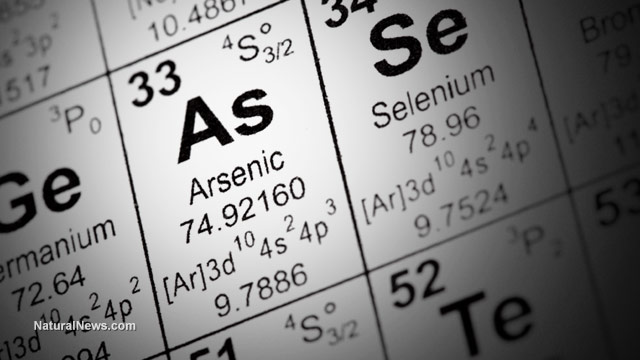Infants fed rice have twice as high urinary arsenic concentrations than infants fed no rice
Wednesday, May 18, 2016 by: S. Johnson
Tags: infants, rice cereal, arsenic contamination

(NaturalNews) Rice cereal is one of the most widely consumed solid foods among infants, primarily because it has a mushy texture and is easy to digest. Nevertheless, parents may want to be careful about how much rice they feed their children. A recent study, published online by JAMA Pediatrics, found that infants who consume rice and rice products had higher urinary arsenic concentrations than infants who did not do so.
Exposure to inorganic arsenic from white and brown rice is a growing problem among infants, and can impair a child's immune system and cognitive development. Inorganic arsenic is the most toxic form of arsenic. Since rice is grown in water, it easily absorbs inorganic arsenic. When arsenic poisoning becomes acute, it can spur a host of symptoms, including diarrhea, vomiting, stomach pain, blood in the urine and even cramps. It affects organs throughout the body, including the skin, lungs, kidneys and liver.
"Arsenic is a known carcinogen that can influence risk of cardiovascular, immune and other diseases," noted lead author of the study, Margaret Karagas, an epidemiologist at Dartmouth College. "There's a growing body of evidence that even relatively low levels of exposure can have an adverse impact on young children."
Infant rice consumption
The authors of the recent study reviewed the dietary data of 759 infants that were part of a New Hampshire Birth Cohort Study conducted between 2011 and 2014. At the beginning of the research project, the team requested that parents keep a food log. The researchers phoned the parents once every four months until the infants were 12 months of age. When the infants turned one year old, the team reviewed their dietary patterns. Specifically, the researchers asked the parents how much rice and rice-based products they had fed their infants, including rice cereal, white or brown rice, rice-based snacks and cereal bars.The team found that approximately 80 percent of infants were introduced to rice cereal during the first year of life, with approximately 64 percent starting to consume rice cereal at 4 to 6 months. At 12 months, an estimated 43 percent of infants had consumed some sort of rice product in the past week; 13 percent had consumed white rice and 10 percent brown rice, on average once or twice a week.
Furthermore, approximately 24 percent of the infants consumed an average of five to six meals made with rice or sweetened rice syrup each week. According to data the parents recorded in their food logs, exactly 71 infants had eaten some sort of rice product two days before urine samples were collected.
The results of the study revealed that among 129 urine samples collected at 12 months, arsenic concentrations were significantly higher for infants who consumed rice or rice based products, in comparison to infants who did not consume any rice. The total urinary arsenic concentrations were twice as high for infants who ate white or brown rice in comparison to infants who ate no rice. Arsenic levels were highest in infants who ate baby rice cereals, which is fed to infants often to introduce them to solids.
In April, the FDA proposed a limit of 100 parts per billion of inorganic arsenic in infant rice cereal, in order to curb the long-term health effects of the element. The European Food Safety Authority set a similar limit for inorganic arsenic in infant rice cereal.
The price of rice
Previous research has demonstrated that exposure to even low levels of arsenic can impair an infant's neurological development. According to a separate 2004 study, researchers found that Bangladeshi children who were exposed to arsenic through drinking water scored significantly lower on IQ tests. In addition, a meta-analysis on the matter found a link between a 50 percent spike in urinary arsenic concentrations and a 0.4-point decrease in the IQ of children between the ages of 5 and 15.There were limitations to the recent study, however. The data was obtained through self-reports, which increases the risk of error. In addition, the study was based on a population in New England with an unregulated water system, which may have generalized the results. Finally, the study did not account for other sources of arsenic other than the water supply, such as apple juice.
"Our results indicate that consumption of rice and rice products increases infants' exposure to As [arsenic] and that regulation could reduce As exposure during this critical phase of development," the authors of the study concluded.
Parents who want to reduce their infant's exposure to arsenic may want to consider replacing rice cereal, which contains a dearth of nutrients, with soft foods like avocado, pureed vegetables and peanut butter oatmeal.
Sources include:
JamaPediatrics
JAMANetwork
CNN
Newsweek
ABCNews
Infants at FETCH.news
Get independent news alerts on natural cures, food lab tests, cannabis medicine, science, robotics, drones, privacy and more.
Take Action: Support Natural News by linking to this article from your website
Permalink to this article:
Embed article link: (copy HTML code below):
Reprinting this article:
Non-commercial use OK, cite NaturalNews.com with clickable link.
Follow Natural News on Facebook, Twitter, Google Plus, and Pinterest
- Newly released JFK files reveal Pentagon's role in creating Lyme disease and covid in the same lab
- Discovery of vast underground city beneath Giza pyramids challenges human history
- Black cumin seed oil emerges as a powerful ally against breast cancer and chronic inflammation
- Sugar-free deception: Artificial sweeteners hijack hunger signals, fuel obesity epidemic, study warns
- Kiss Your Genetic Privacy Good-Bye! 23andMe Gets Green Light to Sell Your Intimate Genetic Details to Anyone They Want
- Aluminum pollution: A silent threat to human health
- Dr. Suzanne Humphries makes bombshell appearance on Joe Rogan podcast, exposing vaccine industry deception back to POLIOMYELITIS
- Sweden's migrant crisis deepens as failed green energy venture leaves thousands jobless, exposes systemic collapse
- Is the vaccine-autism debate reopening? Washington Post sparks controversy with preemptive hit piece on David Geier
- A handful of pecans a day could keep heart disease at bay, study finds
- The mighty Eggplant: An underrated superfood with ancient roots
- Analysis: The coming economic collapse, a mass uprising and Trump's three secret weapons to halt the growing revolt
- The great crypto power struggle: How technocrats and governments are reshaping global finance
- Challenging the status quo: “America Fooled” by Timothy Scott exposes the myths about antidepressants
- RFK Jr. slashes HHS bureaucracy, saves taxpayers $1.8B while refocusing on chronic disease epidemic
- AI breakthrough slashes celiac disease diagnosis time from months to minutes
- HIGH-FAT FOOD DEPRESSION: Scientists discover why obesity takes away the pleasure of eating
- Understanding the difference: “Food Allergies and Food Intolerance” by Dr. Jonathan Brostoff and Linda Gamlin
- Newly released JFK files reveal Pentagon's role in creating Lyme disease and covid in the same lab
- Analysis: The coming economic collapse, a mass uprising and Trump's three secret weapons to halt the growing revolt
- Trump nominates VACCINE ZEALOT Susan Monarez to lead the CDC, sidelining RFK Jr.'s reform efforts
- Trump's greatest betrayal so far: Accelerating Middle East wars, silencing dissent, and serving Zionist masters
- Dr. Mike Yeadon releases 15-minute testimony - WATCH - about genocidal intent of COVID “vaccines”
- Festive flavors: The sweet history, nutritional profile and health benefits of pecan pie
- Elon Musk: Aliens could be here on Earth RIGHT NOW
- Big Pharma's $8 Billion bribery scheme exposed: how doctors are pushed to prescribe junk science, not heal
- 5 Simple steps to boost your brainpower: How to strengthen executive function in a distracted world
- Trump reverses course on Gaza plan, says “nobody is expelling Palestinians”
- A lack of integrity in Academia: Harvard professor found GUILTY of fraudulent research to promote CRT theory
- Reclaim your health: How midlife exercise reverses years of inactivity
- Survival 101: Effective EMF blocking techniques
- Florida takes a stand: DeSantis proposes permanent ban on mRNA vaccine mandates
- Sugarcane extract superior to cholesterol-lowering drugs?
- California's social media censorship law struck down: A victory for free speech or a threat to online safety?
- OpenAI whistleblower who dissented against how the company trained ChatGPT found dead
- EPA advisor admits the agency is funneling billions to climate groups ahead of Trump’s return to White House
- EPA advisor admits the agency is funneling billions to climate groups ahead of Trump’s return to White House
- Newly released JFK files reveal Pentagon's role in creating Lyme disease and covid in the same lab
- California's social media censorship law struck down: A victory for free speech or a threat to online safety?
- Dr. Mike Yeadon releases 15-minute testimony - WATCH - about genocidal intent of COVID “vaccines”
- The Health Ranger releases “Vaccine Zombie” song and music video, using AI-animated zombies for the music video
- The pandemic as a tool for INDOCTRINATION: Understanding “The Indoctrinated Brain” by Dr. Michael Nehls
- Florida takes a stand: DeSantis proposes permanent ban on mRNA vaccine mandates
- “Why we influenced the 2020 elections”: Facebook files reveal the coordinated effort to bury the Hunter Biden laptop story
- Mike Adams releases country western hit single: Goin’ Back in Time is Comin’ Home
- Mike Adams releases music poetry sensation: A Child of God
- Unpacking the Lies That We’ve Been Fed – new song and music video released by Mike Adams, the Health Ranger
- Michigan sheriff announces criminal investigation into 2020 election crimes, Dominion Voting Systems
- Migrants are taking advantage of recent hurricanes to scam residents and loot their homes
- House Intelligence Committee calls for the ARREST and PROSECUTION of Dr. Anthony Fauci
- RFK Jr. clears key hurdle: Sen. Susan Collins backs controversial HHS nominee, signaling a new era for health policy
- Rep. Nancy Mace introduces bill to ban biological males from female facilities on federal property
- Peter Rost exposes Big Pharma corruption in his book “The Whistleblower: Confessions of a Healthcare Hitman”
- Mike Adams releases new song and music video: Nothing More Disgusting Than a Globalist
- Red Cross issues warning to stop blood plasma donations from vaccinated people
- Scientists confirm: GENIUS brain function can be spontaneously unleashed in humans without any apparent cause
- EPA advisor admits the agency is funneling billions to climate groups ahead of Trump’s return to White House
- HYSSOP: What research reveals about the health benefits of this ancient holy herb
- Two containers with completed ballots fall out of truck in Florida
- Fully vaccinated about to see “tsunami” of illness and death, warns virologist
- Global leaders unite to clamp down on “misinformation” with UN-backed Cascais Declaration
- BREAKING: 2025 NDAA authorizes mandatory military draft of WOMEN across America… as Pentagon pursues global NUCLEAR war with both Russia and China at the same time
- Michael Yon warns of a ZIONIST TAKEOVER in Trump’s second administration
- BOMBSHELL: DNA testing kits are a SCAM to develop ethnic-specific bioweapons
- Ozempic and Wegovy weight loss drugs are injectable LIZARD VENOM PEPTIDES that may unleash a devastating wave of organ failure… side effects align with symptoms of SNAKE BITES
- Israeli soldiers accused of even more torture and abuse in the West Bank
- These 13 countries just signed an agreement to engineer a global FAMINE by destroying food supply
- NASA admits that climate change occurs because of changes in Earth’s solar orbit, and NOT because of SUVs and fossil fuels
- RFK Jr. clears key hurdle: Sen. Susan Collins backs controversial HHS nominee, signaling a new era for health policy
- Sermon 30: How Jesus reveals Caesar’s FAKE CURRENCY and FALSE AUTHORITY
- Coriander seeds: Ancient medicine backed by modern science
- Arizona officials claim Maricopa County needs 10-13 days to tabulate results of the election
Science News & Studies
Medicine News and Information
Food News & Studies
Health News & Studies
Herbs News & Information
Pollution News & Studies
Cancer News & Studies
Climate News & Studies
Survival News & Information
Gear News & Information
News covering technology, stocks, hackers, and more



"Big Tech and mainstream media are constantly trying to silence the independent voices that dare to bring you the truth about toxic food ingredients, dangerous medications and the failed, fraudulent science of the profit-driven medical establishment.
Email is one of the best ways to make sure you stay informed, without the censorship of the tech giants (Google, Apple, Facebook, Twitter, YouTube, etc.). Stay informed and you'll even likely learn information that may help save your own life."
–The Health Ranger, Mike Adams












































